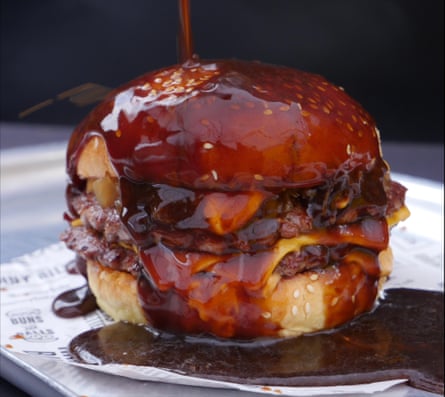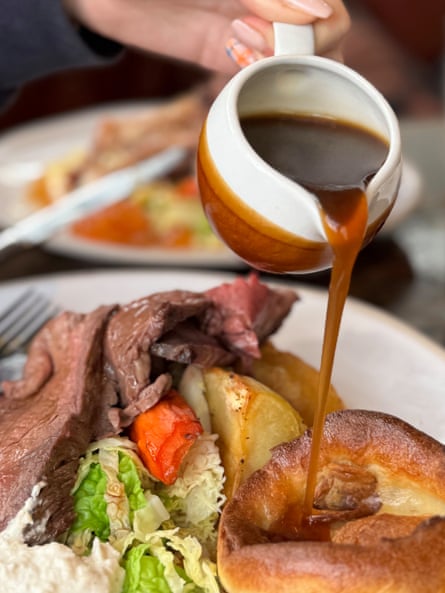Pub roasts, grannies, Sunday lunch, Ah! Bisto!: gravy triggers nostalgic food memories for Britons like little else. But unlike complex French sauces, for example, gravy is brown and plain, not gastronomic alchemy. Its homely bedfellows – potatoes and pies – have had fancy makeovers, but gravy’s potential hasn’t been much exploited on the modern menu. Until now.
The nostalgic wave sweeping Britain’s food scene is reviving this ancient staple, but with a twist: gravy is going gourmet. It is appearing as a dip for burgers in London at the upmarket chain Burger & Beyond and at Nanny Bill’s. It is served with brioche and black pudding at Tom Cenci’s modern British restaurant Nessa in Soho, and even does a turn at Shaun Rankin’s Michelin-starred Grantley Hall in Yorkshire, where it is styled as beef tea and served with bread, bone marrow butter and dripping.
More radically, Hackney Gelato and KFC collaborated on gravy gelato recently – and it sold out in days. “It features rich notes of peppercorn and, of course, chicken,” its creators wrote. “It stinks … is it for cats?” a TikTok reviewer responded, revolted by the combination of sweet cream and meat.
Regardless of where you stand on chickeny ice-cream, there is no doubt that gravy is undergoing “a gastronomic reawakening”, says Gurdeep Loyal, a food writer. “Good gravy is a vehicle to amplify rather than dilute – so it’s gone from an everyday sauce to something that can take a dish to the next level.”
He adds: “Gravy should taste more of the meat than the meat itself. That’s the magic of it; it’s an intensification.” Rankin agrees: “Previously chefs have been focused on sauces with no fat, but now it’s all about strong flavours and you only get that with natural fats.” He has created a dish called Bread, Butter, Dripping, Beef Tea, which is based, he says, “around my childhood memories of Sunday lunch at home where my mum would lift the roast beef out of the oven, then give me a slice of bread to dip into the juices. I brought all those flavours together for this bread course.”
As the title of Loyal’s new book Flavour Heroes: 15 Modern Pantry Ingredients to Amplify Your Cooking suggests, it is all about amplification. Like custard, potatoes and pies, gravy taps into nostalgia, but also has the potential to transform texture and enhance taste. “For ages people were obsessed with making everything crispy and crunchy: pangrattato – crispy breadcrumbs – and so on,” says Loyal. “Now we’re after the antithesis: drowning. The celebration of the soggy! Your taste buds are concentrated on the sides and the tip of your tongue, so you’ll get more taste from something drowned.”

“Gravy is not jus. It is not a glaze. It is gravy,” says chef Stevie Parle, in the matter-of-fact manner of a Birmingham man known and loved for his unfussy approach to cooking. At the chef’s latest opening, Town in central London, gravy is served with a hunk of potato sourdough as a snack. It is rich, brown and laced with meaty bits. “I don’t know that I am elevating it,” he says. “I’m just making a really, really good one.”
“There’s nothing nicer then meat left over from a roast, made into sandwiches and dipped in gravy,” says Craig Povoas, co-founder of Burger & Beyond. The dips there include a pot of bone marrow gravy, and it is also selling posh sandwiches with dips, such as the British French Dip, a baguette filled with rump steak, gruyère cheese and caramelised onions with beef gravy on the side. “It’s inspired by the French dip sandwich which is popular in the United States,” Povoas says – an invention that is French only insofar as a baguette is generally the vehicle for the generous pot of gravy that comes with it.
“Gravy is evolving,” says Zoe Simons, senior brand development chef at Waitrose, which has recently seen “a big push towards using broths and stocks to create more sophisticated gravies at home”. Even the culinary director of Claridge’s, Simon Attridge, a man you would expect to stick to the script as far as tradition is concerned, is partial to dipping french fries into a mix of mayonnaise and red wine gravy. One of his favourite gravy dishes is “a rich madeira-based chicken gravy, infused into butter with crispy chicken skin and served with soft milk bread”.
There is a thrill in taking something golden and crisp like yorkshire pudding and drowning it in gravy, but there’s a cultural dimension, too, to the nostalgia and to the rebellious streak in gravy. Though almost every other “British” food is not British at all, gravy is “something the British have proudly made up, all by ourselves”, the food historian Pen Vogler writes in her book Scoff: A History of Food and Class in Britain. Even the word itself is believed to have derived from a mistranscription of the old French for “ingredient”, grané.
That is as French as gravy has ever been, Vogler says. Where French sauces are skilfully conceived in a pot with vegetables and quality meat, gravy is the stuff that comes out of the meat as it roasts, and the sticky bits left in the pan. It is what gave us an international reputation for dry meat, which is perhaps why gravy became a little “déclassé, something demanded by the sort of diner who has not been educated in the highest flights of French gastronomy to despise overdone meat”, says Vogler. The more the joint was squeezed for gravy, the drier the meat, the more gravy was necessary, creating “a culinary vicious circle” that left cooks scrambling for increasingly inventive ways to make enough gravy to lubricate their meal.

Before the invention of Bisto and the Oxo cube in the early 20th century, gravy was firmly in the “bung it in and see” school of culinary thought. Vogler lists “caramel, salt, pickles” as examples of “supplements” for gravy – to which my grandma would add leftover veg, any dregs of cream or fat she had saved in the fridge, and a splash of raw batter from the yorkshire puddings. “That’s a very Yorkshire thing,” Rankin says. “My mum also used part of the pudding mix as a thickening agent, adding a splash to the tray the beef had roasted in, where all the juices were.” Povoas says: “Everyone has their own take, whether it’s Bisto or elevated.”
Unlike with French sauces, there are no definitive gravy recipes. Vogler points out that “recipes for anything like ‘gravy’ in French, Italian, Spanish or other cookbooks are notable by their absence”. The food historian Alan Davidson described gravy as “a term comprehensible to those who use it, but something of a mystery in the rest of the world”. In the past, this placed it beneath the regard of British chefs intent on proving themselves – and their meat – worthy of gastronomic consideration. But now nostalgia, quality produce and the trumping of fat and flavour over pared-back sophistication have made gravy a go-to item for chefs wanting to celebrate Britain’s culinary heritage and have some fun.
“It’s not cheffy in the way that chefs like to refine and refine,” says Parle. “It’s about scraping all those tasty bits in the pan. It’s about getting down and dirty.” The bone marrow gravy at Burger & Beyond may taste better than the one you grew up with, says Povoas, but it’s still gravy. “It’s just one of those British things that everyone loves.” There’s an insouciance to this sauce, which steals flavour from the meat only to return it tenfold, covering everything in an umami wash of brown.
“I don’t know what makes gravy, gravy,” Parle says with a shrug, “but I do know that if someone says: ‘It’s all gravy,’ it means they are having a good time.”

 3 months ago
95
3 months ago
95

















































